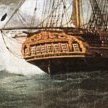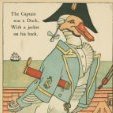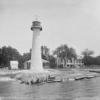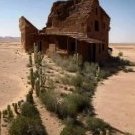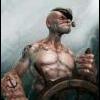-
Posts
406 -
Joined
-
Last visited
Reputation Activity
-
 Patrick Matthews got a reaction from mtaylor in Wood deck on steam tug
Patrick Matthews got a reaction from mtaylor in Wood deck on steam tug
Thanks.
It's actually my understanding that joggling/nibbling has everything to do with allowing a trunnel to be placed near the end of the plank without risk of splitting a narrow end.
BTW, for both Decker (an all wood tug) and Brooklyn (a steel tug with a wood deck), the deck planks are laid over beams, with no subdeck. Decker will be fastened with trunnels, and Brooklyn will have counterbored and plugged holes, with bolts fastening the planks to the beams' flanges.
-
 Patrick Matthews got a reaction from mtaylor in Wood deck on steam tug
Patrick Matthews got a reaction from mtaylor in Wood deck on steam tug
OK, did my searching here and found:
Clear!
Thanks for the help everyone, it's been a blast.
-
 Patrick Matthews got a reaction from mtaylor in Wood deck on steam tug
Patrick Matthews got a reaction from mtaylor in Wood deck on steam tug
And why no joggling here?
My guess is that the steep angle of approach means the cut plank ends aren't "too" pointy, therefore joggling isn't needed to allow for secure attachment close to the end. A more slender yacht will have a shallower approach & sharper ends, so joggling is called for.
I think I've seen a rule-of-thumb for this... anyone have that handy?
-
 Patrick Matthews got a reaction from mtaylor in Wood deck on steam tug
Patrick Matthews got a reaction from mtaylor in Wood deck on steam tug
And here is Decker's foredeck during restoration.
Hmm, I have to assume this is being done in a prototypical fashion?
And nothing like Brooklyn's 3x3 deck planks!
-
 Patrick Matthews got a reaction from mtaylor in Wood deck on steam tug
Patrick Matthews got a reaction from mtaylor in Wood deck on steam tug
Well, I found a video and a still of W.O. Decker that show:
- Planks curving to follow the deck edge;
- Apparently NO joggling at the king plank, just pointy-ended planks.
I wonder if that's the original layout?
-
 Patrick Matthews got a reaction from mtaylor in Wood deck on steam tug
Patrick Matthews got a reaction from mtaylor in Wood deck on steam tug
I'm attempting to do a more-correct version of the Dumas Brooklyn tug, and am stuck on the deck.
Brooklyn (designed 1910) had a steel hull and steel deck beams, but an all-wood deck. The kit would have us scribe plywood sheet with a straight fore-aft planking pattern. Doesn't seem right.
Brooklyn's deck house sides "parallel" the deck edge in plan view, and the one cross section view we have from the original plans show 3x3 pine deck planks between the waterways. (Is the beveled plank adjacent to the deck house also a "waterway"?). Anyway, this suggests that the planking would follow the deck edge curvature over the fore & after decks, which leads to joggling at a central king plank. But I have found no plan or photographic evidence that this was done on tugs of this era.
Anyone have better info before I go and joggle a whole bunch of planks in vain?
-
 Patrick Matthews got a reaction from Keith Black in Wood deck on steam tug
Patrick Matthews got a reaction from Keith Black in Wood deck on steam tug
And here is Decker's foredeck during restoration.
Hmm, I have to assume this is being done in a prototypical fashion?
And nothing like Brooklyn's 3x3 deck planks!
-
 Patrick Matthews got a reaction from Keith Black in Wood deck on steam tug
Patrick Matthews got a reaction from Keith Black in Wood deck on steam tug
Well, I found a video and a still of W.O. Decker that show:
- Planks curving to follow the deck edge;
- Apparently NO joggling at the king plank, just pointy-ended planks.
I wonder if that's the original layout?
-
 Patrick Matthews got a reaction from Keith Black in Wood deck on steam tug
Patrick Matthews got a reaction from Keith Black in Wood deck on steam tug
I'm attempting to do a more-correct version of the Dumas Brooklyn tug, and am stuck on the deck.
Brooklyn (designed 1910) had a steel hull and steel deck beams, but an all-wood deck. The kit would have us scribe plywood sheet with a straight fore-aft planking pattern. Doesn't seem right.
Brooklyn's deck house sides "parallel" the deck edge in plan view, and the one cross section view we have from the original plans show 3x3 pine deck planks between the waterways. (Is the beveled plank adjacent to the deck house also a "waterway"?). Anyway, this suggests that the planking would follow the deck edge curvature over the fore & after decks, which leads to joggling at a central king plank. But I have found no plan or photographic evidence that this was done on tugs of this era.
Anyone have better info before I go and joggle a whole bunch of planks in vain?
-
 Patrick Matthews got a reaction from John Murray in Photographing your models
Patrick Matthews got a reaction from John Murray in Photographing your models
I've taken plenty of photos of my models, mostly in-process on the work bench. Sometimes I'll make an effort to take some beauty shots, always with so-so results. But my brother, who is a pro photographer, showed me some tricks using my PILAR model. Am I likely to pick up the same tools he has? Not too likely, but a lot of it actually isn't too much of an add, assuming you already have a decent camera.
My impromptu lesson took place in my garage, with a big piece of black fabric for a back drop, and a coffee table to hold up the model.
The main "tool" was a soft box- a big umbrella like thing with diffusers and a strobe inside. This was arranged over the model to rain soft parallel light down from above. We played with a reflector panel to get some bounce-fill, and even resorted to an old photo flood to fill in a dark spot. The process had a lot of trial and error: take a shot, examine it, adjust the lighting, it was all magic to me.
It was hardly a complete studio, but we made do with it to get some decent shots. See more in the scratch build gallery under PILAR.
My brother Wil doing his thing in the garage:
Better view of the soft box and reflector:
Using an old flood to fill in:
... to get results like this:
-
 Patrick Matthews got a reaction from Marcus.K. in Constitution's Guns?
Patrick Matthews got a reaction from Marcus.K. in Constitution's Guns?
Thx, I think.
p.83: "1. 24-pdr English long gun"
It's already been established that contrary to an earlier opinion, she DIDN'T (for the most part) carry English guns.
Probably doesn't matter much, they all looked about the same!
Except for the mistaken English markings cast on the 1930 repro guns...
-
 Patrick Matthews got a reaction from TheDuckDetective in Any Delftship users here?
Patrick Matthews got a reaction from TheDuckDetective in Any Delftship users here?
Here's an end view showing some of these features:
White: Original control points and the control mesh with its straight Tinkertoy connectors. The control points lay on the proper body sections from the lines drawing.
Green: Body sections cut through the DS developed hull surface... they miss by a lot. Even at the deck edges.
Pink: Nice curvy marker curves that DS draws for the second import of the original control points. These markers are the target, I need to move the green lines to match them.
To move any one point: Click on it, and you can enter new numbers or use the little arrow to move the point by set increments, very handy. Move each and every one this way to drag the developed sections around.
-
 Patrick Matthews got a reaction from Kenneth Powell in PILAR by Patrick Matthews - 1:12 - RADIO - Ernest Hemingway's boat
Patrick Matthews got a reaction from Kenneth Powell in PILAR by Patrick Matthews - 1:12 - RADIO - Ernest Hemingway's boat
The complete build log is on RCGroups
https://www.rcgroups.com/forums/showthread.php?2316931-PILAR-in-1-12
Hope to see pics of yours!
-
 Patrick Matthews got a reaction from FreekS in PILAR by Patrick Matthews - 1:12 - RADIO - Ernest Hemingway's boat
Patrick Matthews got a reaction from FreekS in PILAR by Patrick Matthews - 1:12 - RADIO - Ernest Hemingway's boat
Cabin is constructed of ply and basswood, with all exposed wood done in cherry. The real boat appears to have been built with mahogany, but I find that cherry "works" better, and has a better scale grain appearance. The sides are built up as a 3d jigsaw puzzle, as many as 3 layers deep. They hang down straight like a curtain from the deck intersection, but angle inwards at 2° from that line up, while also following the sheer... a bit tricky.
The cabin roofs are covered with shirt cloth to simulate canvas. The cloth is secured with water based polyurethane, painted, and clear coated. The weave still shows through, like painted canvas.
The cherry is all stained with Minwax "Gunstock", and clear coated with lacquer. Warning: Most all of my cherry stained a very nice color, but occasional pieces turned orange, yuk. Always test!
.
I changed my mind after this shot and added the forward cockpit.
Roof beams
First piece of cloth installed
-
 Patrick Matthews got a reaction from FreekS in PILAR by Patrick Matthews - 1:12 - RADIO - Ernest Hemingway's boat
Patrick Matthews got a reaction from FreekS in PILAR by Patrick Matthews - 1:12 - RADIO - Ernest Hemingway's boat
Most of the model is hand built from wood of course... but certain components were printed- either in plastic, or in wax for investment casting in bronze. Such as the struts and rudder footing. The footing works with the extended wood skeg, a common design layout in the 20's and 30's. This casting is missing from the boat at Finca Vigia, which leads some modelers to make some odd drive arrangements. If only they knew...
Hemingway had Wheeler make several well known modifications to Pilar, including the installation of an auxiliary 4 cylinder Lycoming for trolling. There is no evidence of this on the boat now, so this is also omitted from models.
.
-
 Patrick Matthews got a reaction from Roger Pellett in PILAR by Patrick Matthews - 1:12 - RADIO - Ernest Hemingway's boat
Patrick Matthews got a reaction from Roger Pellett in PILAR by Patrick Matthews - 1:12 - RADIO - Ernest Hemingway's boat
Most of the model is hand built from wood of course... but certain components were printed- either in plastic, or in wax for investment casting in bronze. Such as the struts and rudder footing. The footing works with the extended wood skeg, a common design layout in the 20's and 30's. This casting is missing from the boat at Finca Vigia, which leads some modelers to make some odd drive arrangements. If only they knew...
Hemingway had Wheeler make several well known modifications to Pilar, including the installation of an auxiliary 4 cylinder Lycoming for trolling. There is no evidence of this on the boat now, so this is also omitted from models.
.
-
 Patrick Matthews got a reaction from mtaylor in PILAR by Patrick Matthews - 1:12 - RADIO - Ernest Hemingway's boat
Patrick Matthews got a reaction from mtaylor in PILAR by Patrick Matthews - 1:12 - RADIO - Ernest Hemingway's boat
The complete build log is on RCGroups
https://www.rcgroups.com/forums/showthread.php?2316931-PILAR-in-1-12
Hope to see pics of yours!
-
 Patrick Matthews got a reaction from Dave boatswain in Photographing your models
Patrick Matthews got a reaction from Dave boatswain in Photographing your models
I've taken plenty of photos of my models, mostly in-process on the work bench. Sometimes I'll make an effort to take some beauty shots, always with so-so results. But my brother, who is a pro photographer, showed me some tricks using my PILAR model. Am I likely to pick up the same tools he has? Not too likely, but a lot of it actually isn't too much of an add, assuming you already have a decent camera.
My impromptu lesson took place in my garage, with a big piece of black fabric for a back drop, and a coffee table to hold up the model.
The main "tool" was a soft box- a big umbrella like thing with diffusers and a strobe inside. This was arranged over the model to rain soft parallel light down from above. We played with a reflector panel to get some bounce-fill, and even resorted to an old photo flood to fill in a dark spot. The process had a lot of trial and error: take a shot, examine it, adjust the lighting, it was all magic to me.
It was hardly a complete studio, but we made do with it to get some decent shots. See more in the scratch build gallery under PILAR.
My brother Wil doing his thing in the garage:
Better view of the soft box and reflector:
Using an old flood to fill in:
... to get results like this:
-
 Patrick Matthews got a reaction from Scottish Guy in chain sources
Patrick Matthews got a reaction from Scottish Guy in chain sources
That fine chain is all very fine... but if you need some chunky stud-link anchor chain, it can be printed!
-
 Patrick Matthews got a reaction from highlanderburial in USLSS 36'Lifeboat
Patrick Matthews got a reaction from highlanderburial in USLSS 36'Lifeboat
The 3D CAD model is complete and available for free download from GrabCAD:
https://grabcad.com/library/lifeboat-uslss-1908-mclellen-type-e-36-footer-1
Find the 3D STEP file there, along with reference photos and the original 2D drawings I worked from.
Take the model for a spin at GrabCAD!
-
 Patrick Matthews got a reaction from Montaigne in PILAR by Patrick Matthews - 1:12 - RADIO - Ernest Hemingway's boat
Patrick Matthews got a reaction from Montaigne in PILAR by Patrick Matthews - 1:12 - RADIO - Ernest Hemingway's boat
Designed in CAD starting in 2015. Made a few changes... since 2015, I built a whole new hull and a whole new cabin, tossing the previous versions. Accurate plans don't exist, but overall dimensions are known, and there's a decent profile from a sale brochure for Wheeler Playmates.
-
 Patrick Matthews got a reaction from Montaigne in PILAR by Patrick Matthews - 1:12 - RADIO - Ernest Hemingway's boat
Patrick Matthews got a reaction from Montaigne in PILAR by Patrick Matthews - 1:12 - RADIO - Ernest Hemingway's boat
Most of the model is hand built from wood of course... but certain components were printed- either in plastic, or in wax for investment casting in bronze. Such as the struts and rudder footing. The footing works with the extended wood skeg, a common design layout in the 20's and 30's. This casting is missing from the boat at Finca Vigia, which leads some modelers to make some odd drive arrangements. If only they knew...
Hemingway had Wheeler make several well known modifications to Pilar, including the installation of an auxiliary 4 cylinder Lycoming for trolling. There is no evidence of this on the boat now, so this is also omitted from models.
.
-
 Patrick Matthews got a reaction from Montaigne in PILAR by Patrick Matthews - 1:12 - RADIO - Ernest Hemingway's boat
Patrick Matthews got a reaction from Montaigne in PILAR by Patrick Matthews - 1:12 - RADIO - Ernest Hemingway's boat
Cabin is constructed of ply and basswood, with all exposed wood done in cherry. The real boat appears to have been built with mahogany, but I find that cherry "works" better, and has a better scale grain appearance. The sides are built up as a 3d jigsaw puzzle, as many as 3 layers deep. They hang down straight like a curtain from the deck intersection, but angle inwards at 2° from that line up, while also following the sheer... a bit tricky.
The cabin roofs are covered with shirt cloth to simulate canvas. The cloth is secured with water based polyurethane, painted, and clear coated. The weave still shows through, like painted canvas.
The cherry is all stained with Minwax "Gunstock", and clear coated with lacquer. Warning: Most all of my cherry stained a very nice color, but occasional pieces turned orange, yuk. Always test!
.
I changed my mind after this shot and added the forward cockpit.
Roof beams
First piece of cloth installed
-
 Patrick Matthews got a reaction from Scallywag in Constitution's Guns?
Patrick Matthews got a reaction from Scallywag in Constitution's Guns?
Thx, I think.
p.83: "1. 24-pdr English long gun"
It's already been established that contrary to an earlier opinion, she DIDN'T (for the most part) carry English guns.
Probably doesn't matter much, they all looked about the same!
Except for the mistaken English markings cast on the 1930 repro guns...
-
 Patrick Matthews got a reaction from ibozev in Photographing your models
Patrick Matthews got a reaction from ibozev in Photographing your models
I've taken plenty of photos of my models, mostly in-process on the work bench. Sometimes I'll make an effort to take some beauty shots, always with so-so results. But my brother, who is a pro photographer, showed me some tricks using my PILAR model. Am I likely to pick up the same tools he has? Not too likely, but a lot of it actually isn't too much of an add, assuming you already have a decent camera.
My impromptu lesson took place in my garage, with a big piece of black fabric for a back drop, and a coffee table to hold up the model.
The main "tool" was a soft box- a big umbrella like thing with diffusers and a strobe inside. This was arranged over the model to rain soft parallel light down from above. We played with a reflector panel to get some bounce-fill, and even resorted to an old photo flood to fill in a dark spot. The process had a lot of trial and error: take a shot, examine it, adjust the lighting, it was all magic to me.
It was hardly a complete studio, but we made do with it to get some decent shots. See more in the scratch build gallery under PILAR.
My brother Wil doing his thing in the garage:
Better view of the soft box and reflector:
Using an old flood to fill in:
... to get results like this:




